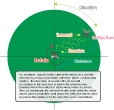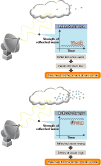


 Radar Wall
Radar Wall

 Radar
Radar
Radars are devices that use radio waves to examine an object�$B!G�(Bs distance, direction, velocity and properties.
For example, an airport radar emits radio waves from an antenna and receives reflected waves from aircraft that reveal the aircraft�$B!G�(Bs speed and direction. Information can also be gathered through radar regarding the conditions inside clouds and the movement of seawater. Examining distant objects in this way is called "remote sensing", and radar represents one way of doing this.

 How can distance and direction be detected?
How can distance and direction be detected?

 Can it be picked up by radar?
Can it be picked up by radar?
Information about an object in a distant location can be gathered by using a distance and direction radar.
For example, airport radars emit radio waves in a specific direction by using a parabolic antenna, which continuously rotates.
 The direction of an aircraft can be told according to the direction in
which the antenna was pointing when the reflected radio waves were received.
Also, by measuring the amount of time from when the radio waves were transmitted
until when the reflected waves were received, the distance to the aircraft
can be calculated. The radar being researched at the Okinawa Electromagnetic
Technology Center can calculate the distance and direction of typhoons
and clouds in the same manner.
The direction of an aircraft can be told according to the direction in
which the antenna was pointing when the reflected radio waves were received.
Also, by measuring the amount of time from when the radio waves were transmitted
until when the reflected waves were received, the distance to the aircraft
can be calculated. The radar being researched at the Okinawa Electromagnetic
Technology Center can calculate the distance and direction of typhoons
and clouds in the same manner.

 Can they be detected by radar ?
Can they be detected by radar ?
 The Doppler effect on radio waves is manifested as changes in frequency.
By utilizing the Doppler effect, the speed of a distant subject can be
measured. The type of radar studied at the Okinawa Electromagnetic Technology
Center is Doppler radar. When observing clouds with the help of Doppler
radar, the speed of a raindrop can be measured; because of this, it is
also possible to measure the speed of wind.
The Doppler effect on radio waves is manifested as changes in frequency.
By utilizing the Doppler effect, the speed of a distant subject can be
measured. The type of radar studied at the Okinawa Electromagnetic Technology
Center is Doppler radar. When observing clouds with the help of Doppler
radar, the speed of a raindrop can be measured; because of this, it is
also possible to measure the speed of wind.
 What is the Doppler effect?
What is the Doppler effect?
 Have you heard of the "Doppler effect" ?
Have you heard of the "Doppler effect" ?
The change in sound of a siren on an ambulance as it speeds past is one familiar example.
The siren on an ambulance is emitted at a constant pitch.
However, to a stationary person, the siren can be heard at a high pitch as the ambulance approaches, and a low pitch as it moves away. This phenomenon occurs according to change in distance between the object emitting sound and the object receiving sound. This is called the Doppler effect.
The Doppler effect does not only occur with sound, but also with radio waves, which are the same kind of wave.
By measuring changes with the Doppler effect, velocity can be determined.

 How can properties of objects be detected ?
How can properties of objects be detected ?
 Can they be detected by radar ? - Properties of objects -
Can they be detected by radar ? - Properties of objects -
 The quantity and shape of objects can be determined by using radar.
The quantity and shape of objects can be determined by using radar.
For example, the amount of rain can be approximately measured depending on whether the reflected wave is strong or weak.
The shape of objects can also be examined by oscillating the direction of transmission of radio waves.
Okinawa Electromagnetic Technology Center uses alignment of radio waves, or polarized waves, in its radar research.
 What is a polarized wave?
What is a polarized wave?
 A radio wave with a specific oscillating direction is called a polarized wave.
A radio wave with a specific oscillating direction is called a polarized wave.
Waves oscillating parallel to the ground are called horizontal polarized waves, and those oscillating perpendicular to the ground are vertical polarized waves.
There are also "circular polarized waves" and "elliptical polarized waves" that move in a rotational direction.
 Detecting the shape of a raindrop with polarized waves The shape of raindrops can be determined by using a polarized wave.
Detecting the shape of a raindrop with polarized waves The shape of raindrops can be determined by using a polarized wave.
 Small raindrops in the atmosphere are spherical, but they become vertically compressed into an elliptical shape when they get larger.
Small raindrops in the atmosphere are spherical, but they become vertically compressed into an elliptical shape when they get larger.
When raindrops are small, there is no difference in the strength of the reflected vertical and horizontal polarized waves.
When the raindrops get bigger, however, the strength of the reflected horizontal polarized waves gets greater.
Through this the shape of raindrops can be determined and their size can be speculated.

 Radar and ultrasonic sound waves made by dolphins Even though dolphins live in the darkness of the sea, they can still search for food in the form of fish.
Radar and ultrasonic sound waves made by dolphins Even though dolphins live in the darkness of the sea, they can still search for food in the form of fish.
 They do this by emitting sound that cannot be detected by the human ear (ultrasonic sound waves) and catching the sound that comes back like an echo. Even though they cannot see their food, they can tell their direction and distance by using ultrasonic sound waves.
They do this by emitting sound that cannot be detected by the human ear (ultrasonic sound waves) and catching the sound that comes back like an echo. Even though they cannot see their food, they can tell their direction and distance by using ultrasonic sound waves.
The way radar works and the way that dolphins use ultrasonic sound waves are much the same.
Radars used at airports emit radio waves from an antenna and catch the radio waves that are reflected off aircraft.
Through this, the direction and distance of aircraft can be detected.